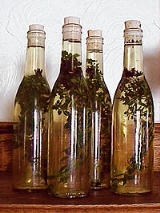
Vinegar
Overview
Acetic acid
Acetic acid is an organic compound with the chemical formula CH3CO2H . It is a colourless liquid that when undiluted is also called glacial acetic acid. Acetic acid is the main component of vinegar , and has a distinctive sour taste and pungent smell...
and water
Water
Water is a chemical substance with the chemical formula H2O. A water molecule contains one oxygen and two hydrogen atoms connected by covalent bonds. Water is a liquid at ambient conditions, but it often co-exists on Earth with its solid state, ice, and gaseous state . Water also exists in a...
, the acetic acid being produced through the fermentation
Fermentation
Fermentation may refer to:* Fermentation , the use of fermentation in food preparation* Fermentation , a metabolic process whereby electrons released from nutrients are ultimately transferred to molecules obtained from the breakdown of those same nutrients* Fermentation , the process of...
of ethanol
Ethanol
Ethanol, also called ethyl alcohol, pure alcohol, grain alcohol, or drinking alcohol, is a volatile, flammable, colorless liquid. It is a psychoactive drug and one of the oldest recreational drugs. Best known as the type of alcohol found in alcoholic beverages, it is also used in thermometers, as a...
by acetic acid bacteria
Acetic acid bacteria
Acetic acid bacteria are bacteria that derive their energy from the oxidation of ethanol to acetic acid during fermentation. They are Gram-negative, aerobic, rod-shaped bacteria. Not to be confused with the genus Acetobacterium which are anaerobic homoacetogenic facultative autotrophs and can...
. Commercial vinegar is produced either by fast or slow fermentation processes. Slow methods generally are used with traditional vinegars, and fermentation proceeds slowly over the course of weeks or months. The longer fermentation period allows for the accumulation of a nontoxic slime composed of acetic acid bacteria.
Unanswered Questions
Discussions

